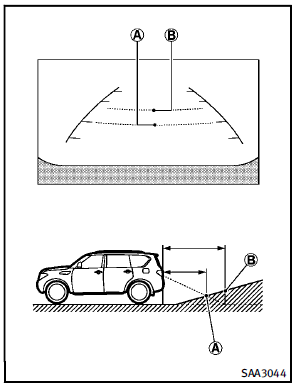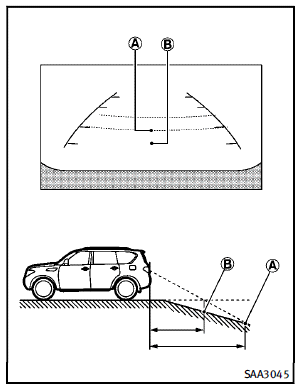Difference between predicted and actual distances

The distance guide line and the vehicle width guide line on the front and the rearview should be used as a reference only when the vehicle is on a level, paved surface. The distance viewed on the monitor is for reference only and may be different than the actual distance between the vehicle and displayed objects.
Moving to a steep uphill

When moving the vehicle up a hill, the distance guide lines and the vehicle width guide lines are shown closer than the actual distance. For example, the display shows 3 ft (1 m) to the place A , but the actual 3 ft (1 m) distance on the hill is the placeB . Note that any object on the hill is viewed in the monitor further than it appears.
Moving to a steep downhill

When moving the vehicle down a hill, the distance guide lines and the vehicle width guide lines are shown further than the actual distance. For example, the display shows 3 ft (1 m) to the place A , but the actual 3 ft (1 m) distance on the hill is the placeB . Note that any object on the hill is viewed in the monitor closer than it appears.
Moving near a projecting object

Moving closer to a projecting object

The position C is shown further than the position B in the display. However, the position C is actually at the same distance as the position A . The vehicle may hit the object when moving toward the position A if the object projects over the actual moving course.
See also:
Passenger compartment
Passenger compartment
CAUTION
Never use a fuse of a higher or lower amperage rating than that specified on the fuse box cover. This could damage the electrical system or cause a fire.
If any elec ...
Securing the load
There are luggage hooks located in the cargo area as shown. The hooks can be used to secure cargo with ropes or other types of straps.
Do not apply a total load of more than 6.5 lbs. (29 N) to a si ...
2012 Infiniti FX35 Review
The Infiniti FX was something of a revelation when it made its 2003 debut. At
the time, there were few sporty SUVs on the market — unless your definition of
sport is the rugged, off-road type rath ...
